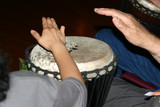West African Djembe Drum Origins
The djembe drum has made a substantial impact on the world of music, from professional to hobby to the drumming of a community drum jam. These drums are as varied as the people who first played them, as well as modern djembefolas who continue to find new ways to include the unique sound and style of the djembe into the music we hear each day. Djembe drums are West African, hailing from places like Senegal, Guinea, Mali and Ghana, and each “style” of djembe has its own unique style and flair.
Senegal djembes have elongated bowls that are sized larger than the flared trumpet of the drum, making these very recognizable to hand percussion aficionados. Djembes from Senegal are constructed with goat skin heads and typically utilize Dimbe, Khadi or Lenke wood, giving a powerful and deep tone to the rhythm.
Guinea djembes are considered to have a wider bowl than other djembes and in terms of length, is about half the side of the drum. The other half of the drum is the trumpet that has relatively small flare at the bottom, allowing for a deeper, resonant tone. The carvings on a djembe from Guinea make this drum a visual delight, as well as a great example of typical djembe sound.
Mali djembe drums use the beauty of Bala or Iroko wood and color variances for the aesthetic appeal, standing out from other djembes due to the artful eye of the craftsman. With a wider trumpet top, and rounded bowl, the sound of the Mali djembe is warm and welcoming, easily blending with any other drums or instruments that are played.
Ghana djembe drums may have less decoration than other djembes, but, they are still beautiful to see and to hear. The wood of the Ghana drum is local to the area, and much softer than other wood used in the construction of djembes, giving djembe rhythms a softer, resonating tone.
The different tones and styles of African djembe drums can be contributed to the land and origins of the instruments. No matter the favorite style of drum, most djembe players will admit that there is a great deal of excitement that comes from discovering the similarities and differences each provides. Since modern djembe drums are based upon these original designs, even the sound of a key-tuned or fiberglass djembe still echos the original rhythms that can only be found in African djembes.
Recent Posts
-
X8 Drums Play-Along Backing Tracks
The new X8 Play-Along Series is being produced for our musician friends wanting a fresh way to work …9th Feb 2025 -
What is the Best Size Djembe for Beginners?
If you're new to the world of percussion and interested in learning the djembe, you're in for a t …16th Jul 2024 -
The Benefits of Becoming a Drumming Teacher: Transforming Passion into Profession
Why become a drumming teacher? Becoming a drumming teacher is an excellent way to share your pas …22nd May 2024




